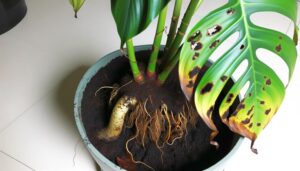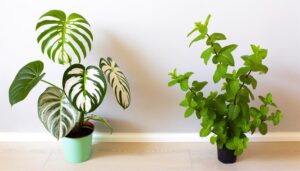Why Are My Monstera Leaves Turning Yellow After Repotting?
Your Monstera’s leaves may turn yellow after repotting due to transplant shock, which stresses the plant and impacts water and nutrient absorption. Overwatering or underwatering can lead to root rot or dehydration, both causing yellowing leaves.
Inadequate drainage or root damage during repotting further exacerbates stress. Ensure the soil is well-draining and handle the roots delicately.
Light, temperature, and humidity changes also play a role in leaf color. Maintain stable conditions and monitor for pests and proper fertilization.
These factors contribute significantly, and understanding them will guide you towards a healthier Monstera.
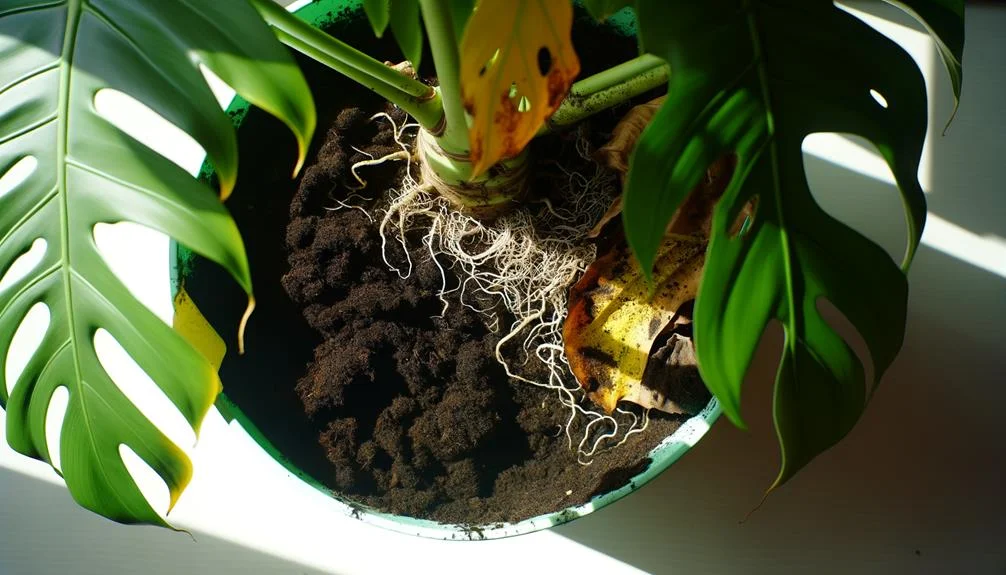
Key Takeaways
- Transplant shock stresses the plant, causing yellowing leaves post-repotting.
- Overwatering or underwatering disrupts the plant’s hydration balance, leading to yellow leaves.
- Inadequate drainage can result in root rot, making leaves turn yellow.
- Root damage during repotting can stress the plant and cause leaf yellowing.
- Poor soil quality affects nutrient uptake, leading to yellowing foliage.
Transplant Shock
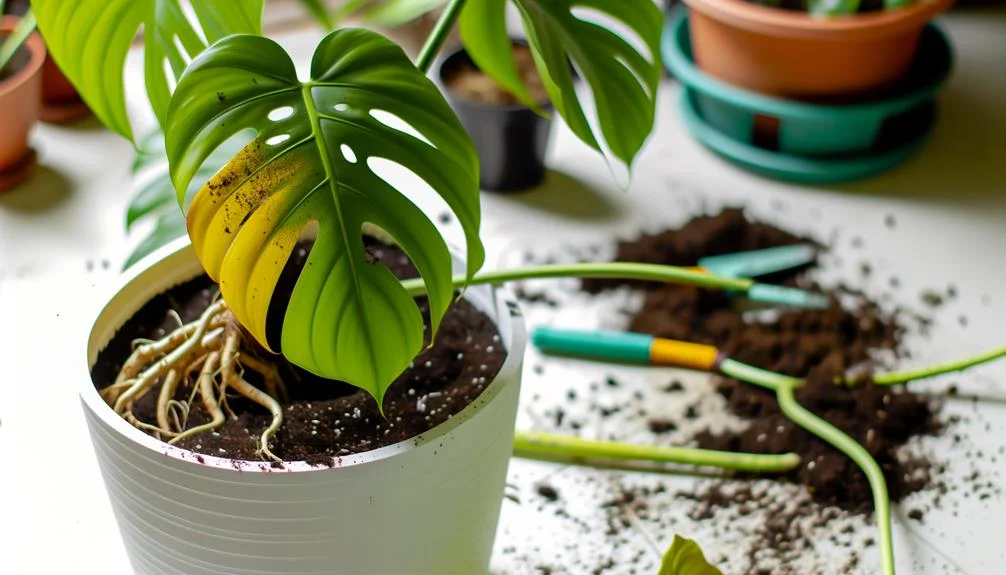
Transplant shock occurs when a Monstera plant experiences stress from changes in its environment, often leading to yellowing leaves as it adjusts to its new pot and soil. This stress response is common after repotting and can be attributed to root disturbance and differing soil composition.
When you repot, the roots might get damaged or exposed, hindering their ability to absorb water and nutrients efficiently. Additionally, a sudden shift in soil pH or texture can disrupt the plant’s nutrient uptake.
To minimize transplant shock, make sure you handle the roots gently and use a well-draining, airy soil mix similar to the previous one. Providing stable environmental conditions will help your Monstera recover and thrive in its new home.
Watering Issues
When repotting your Monstera, it’s essential to manage your watering practices to avoid yellowing leaves.
Overwatering can lead to root rot, while underwatering can cause dehydration stress, both of which manifest as yellow foliage.
Additionally, inadequate drainage exacerbates these issues by preventing proper moisture regulation.
Overwatering Consequences
Overwatering your Monstera after repotting can lead to root rot, a serious condition where the roots become waterlogged and start to decay. This restricts the plant’s ability to uptake nutrients and oxygen, causing yellowing leaves.
To prevent this, follow these steps:
- Check Soil Moisture: Use a moisture meter or your finger to confirm the top inch of soil is dry before watering.
- Ensure Proper Drainage: Use a pot with drainage holes and well-draining soil to prevent water accumulation.
- Adjust Watering Frequency: Water less often, especially during cooler months when the plant’s water needs decrease.
- Monitor Humidity: Maintain moderate humidity levels, as excessively humid conditions can worsen overwatering issues.
Adhering to these practices can help prevent root rot and keep your Monstera healthy.
Underwatering Effects
Insufficient watering after repotting can cause Monstera leaves to turn yellow due to the plant’s inability to access essential moisture and nutrients. When you repot, the root system needs time to adjust and establish itself in the new soil environment.
During this period, if the soil remains too dry, the roots can’t uptake water efficiently. This results in cellular stress and nutrient deficiencies, manifesting as yellow leaves. To monitor and manage this, observe the soil’s moisture levels regularly.
Here’s a table to illustrate:
| Symptom | Cause |
|---|---|
| Yellowing Leaves | Lack of moisture and nutrients |
| Wilting | Inadequate water absorption |
| Dry Soil | Insufficient watering |
Ensuring consistent, adequate watering can help your Monstera thrive post-repotting.
Drainage Problems
Effective drainage is crucial for Monstera plants, as inadequate drainage can result in waterlogged soil and root rot, leading to the leaves turning yellow.
To ensure proper drainage, follow these steps:
- Select a Pot with Drainage Openings: Guarantee that the pot has multiple drainage openings to allow excess water to escape.
- Utilize Well-Draining Soil: A mixture containing perlite or orchid bark enhances aeration and prevents soil compaction.
- Inspect the Drainage Layer: Include a layer of gravel or small stones at the base of the pot to improve water flow.
- Monitor Watering Frequency: Adjust watering based on soil moisture, not a fixed timetable, to prevent overwatering.
Root Damage
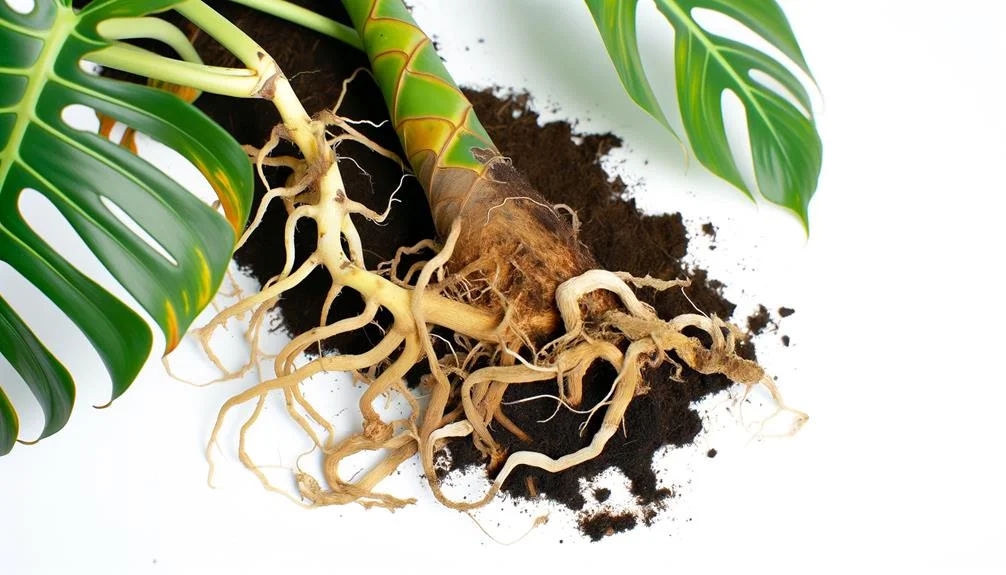
Due to the sensitive nature of Monstera roots, any damage sustained during repotting can greatly impact the plant’s ability to uptake nutrients and water, leading to yellowing leaves.
When you repot, it’s important to handle the root ball gently to avoid breaking or bruising the roots. Damaged roots can develop rot or fail to function properly, preventing the plant from accessing essential resources. Make sure you use sterilized tools to minimize the risk of introducing pathogens.
After repotting, monitor the plant closely for signs of stress and provide optimal conditions to promote root recovery. Keep in mind that even minor root damage can cause significant physiological stress, appearing as yellow leaves and stunted growth.
Soil Quality
Maintaining the soil quality is crucial, as poor soil conditions can worsen the stress caused by root damage during repotting. You need soil that encourages good drainage and aeration.
Consider the following:
- Composition: Use a mix that includes peat moss, perlite, and pine bark to uphold a balance of moisture retention and drainage.
- pH Level: Aim for a slightly acidic to neutral pH (5.5-7.0) to support nutrient absorption.
- Texture: Make sure the soil is loose and well-draining to prevent waterlogging, which can lead to root rot.
- Organic Matter: Integrate organic material to enhance soil structure and microbial activity.
Nutrient Deficiency
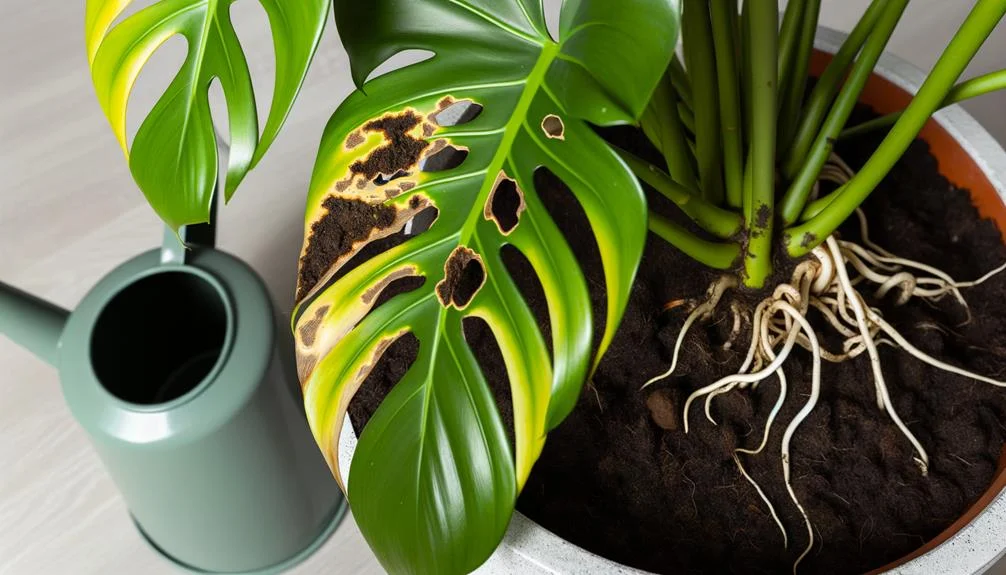
When you repot your Monstera, nutrient deficiencies can quickly become apparent due to soil nutrient imbalance and fertilizer application errors.
You might notice yellowing leaves if the new soil lacks essential minerals or if fertilizer isn’t applied correctly.
Root absorption issues also play a significant role, as disturbed roots may struggle to uptake nutrients efficiently.
Soil Nutrient Imbalance
A key reason your Monstera leaves are turning yellow after repotting is a nutrient deficiency caused by soil nutrient imbalance. When repotting, the new soil mightn’t have the right balance of essential nutrients. This imbalance can disrupt the plant’s ability to absorb what it needs.
Here are four crucial nutrients that could be deficient:
- Nitrogen: Essential for leaf growth, a deficiency causes yellowing.
- Phosphorus: Important for root development, a lack can stunt growth.
- Potassium: Supports overall plant health, and a shortage can affect leaf color.
- Magnesium: Key for chlorophyll production, deficiency results in yellowing between veins.
Monitoring the nutrient content and ensuring balanced soil can help your Monstera thrive post-repotting.
Fertilizer Application Errors
Incorrect fertilizer application can lead to nutrient deficiencies, causing your Monstera’s leaves to turn yellow post-repotting. When you don’t provide the right balance of essential nutrients, your plant suffers.
Over-fertilizing can cause salt buildup in the soil, hindering nutrient uptake. Under-fertilizing leaves the plant lacking vital elements like nitrogen, phosphorus, and potassium, essential for healthy leaf color and growth.
Ensure you’re using a balanced, water-soluble fertilizer. Follow the recommended dosage and frequency, typically every 4-6 weeks during the growing season. Diluting the fertilizer to half-strength can prevent nutrient burn. Additionally, flush the soil with water periodically to remove excess salts.
This careful approach helps maintain nutrient equilibrium, promoting vibrant, green Monstera leaves.
Root Absorption Issues
Poor root absorption can greatly impact your Monstera’s ability to uptake essential nutrients, resulting in yellowing leaves post-repotting. When roots are disturbed during repotting, they may suffer damage, reducing their efficiency. This disruption can lead to nutrient deficiencies, even if the soil is nutrient-rich.
To mitigate this, consider:
- Proper Soil Mix: Use a well-draining, aerated potting mix specifically designed for Monsteras.
- Adequate Watering: Maintain consistent moisture levels without waterlogging, as excessively wet soil can suffocate roots.
- Gentle Handling: Minimize root damage by carefully loosening the root ball and avoiding excessive disturbance.
- Balanced Fertilization: Apply a balanced, diluted fertilizer after a few weeks to support recovery and growth.
Understanding these factors helps maintain your Monstera’s health after repotting.
Light Conditions
To ensure your Monstera thrives after repotting, providing the correct light conditions is essential for preventing yellowing leaves. Monsteras require bright, indirect light to photosynthesize effectively and maintain their vibrant green color.
Direct sunlight can scorch the leaves, causing them to yellow or develop brown spots. Conversely, insufficient light can inhibit chlorophyll production, leading to pale or yellow leaves.
Position your Monstera near an east or north-facing window where it can receive filtered light throughout the day. If natural light is limited, consider using a grow light to supplement. Monitor the light intensity and duration, as overexposure or prolonged low light can stress the plant.
Maintaining ideal light conditions will help your Monstera recover and flourish post-repotting.
Temperature Stress

Temperature fluctuations can significantly impact your Monstera’s health, especially after repotting. When your plant experiences inconsistent temperatures, it can go into shock, leading to yellowing leaves.
To mitigate this, you should:
- Maintain a consistent temperature: Keep it between 65-75°F (18-24°C) for peak growth.
- Avoid drafts: Place your Monstera away from windows and doors that might allow cold air to seep in.
- Monitor heat sources: Guarantee it’s not too close to radiators or heating vents, which can cause uneven warming.
- Use a thermometer: Regularly check the plant’s environment to sustain stable conditions.
Humidity Levels
Inadequate moisture levels can stress your Monstera, often resulting in yellow leaves after repotting. Monsteras thrive in environments with humidity levels between 60-80%.
When you repot, the plant undergoes stress, making it more susceptible to changes in its microenvironment. If the air is too dry, the plant’s transpiration rate increases, causing moisture loss from the leaves and leading to yellowing.
You can mitigate this by misting the leaves regularly, using a humidifier, or placing a tray with water and pebbles beneath the pot to increase local humidity. Monitoring humidity with a hygrometer ensures you maintain ideal levels.
Consistent humidity helps the plant acclimate to its new pot, reducing the risk of yellowing leaves.
Pest Infestation
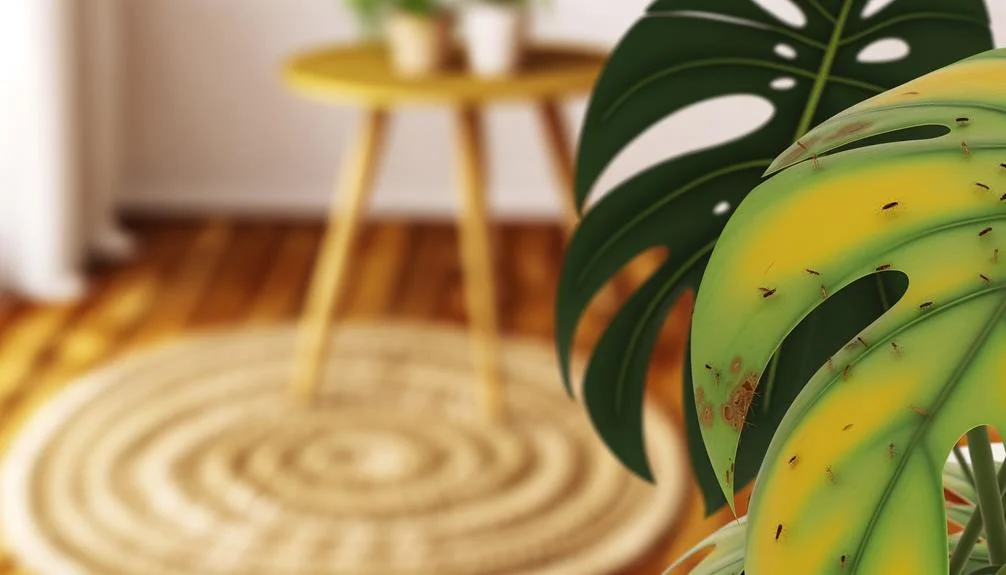
Another factor that can cause yellow leaves after repotting your Monstera is a pest infestation. Pests like spider mites, aphids, mealybugs, and scale insects can stress your plant and disrupt nutrient absorption, leading to yellowing.
Here’s how to identify and manage them:
- Spider Mites: Look for tiny, web-like structures and fine speckling on leaves.
- Aphids: These small, green, or black insects cluster on new growth and undersides of leaves.
- Mealybugs: Identify them by their white, cotton-like appearance, often in leaf joints.
- Scale Insects: These appear as small, brown, or black bumps on stems and leaves.
Regularly inspect your Monstera, and treat infestations with appropriate insecticidal soap or neem oil to protect your plant.
Can Yellow Monstera Leaves Turn Green Again?
No, yellow Monstera leaves typically do not turn green again. Once a leaf turns yellow, it is often a sign of an underlying issue such as overwatering, underwatering, lack of nutrients, or improper lighting.
To prevent further yellowing and maintain a healthy plant, consider the following steps:
- Watering: Ensure you are watering appropriately. Allow the top inch of soil to dry out between waterings. Overwatering can lead to root rot, causing yellow leaves.
- Lighting: Provide bright, indirect light. Too much direct sunlight or insufficient light can cause yellowing.
- Nutrients: Fertilize during the growing season with a balanced, water-soluble fertilizer. A lack of nutrients can lead to yellow leaves.
- Drainage: Make sure the pot has adequate drainage to prevent water from sitting at the roots.
- Humidity: Maintain high humidity levels around the plant, as Monsteras thrive in humid environments.
- Pests: Check for pests such as spider mites, mealybugs, and scale, which can stress the plant and cause yellowing leaves.
Remove the yellow leaves to keep the plant looking healthy and to direct the plant’s energy to new growth.
Conclusion
Your Monstera’s yellowing leaves symbolize its struggle for equilibrium after repotting. Address transplant shock, adjust watering practices, and verify the roots are intact.
Use high-grade soil and provide balanced nutrients. Monitor light conditions, maintain ideal temperature, and ensure sufficient humidity.
Be vigilant for pests. Just like nurturing a delicate balance in nature, your attentive care will restore your Monstera’s vibrant green, transforming it back into the beautiful jungle beacon it once was.

